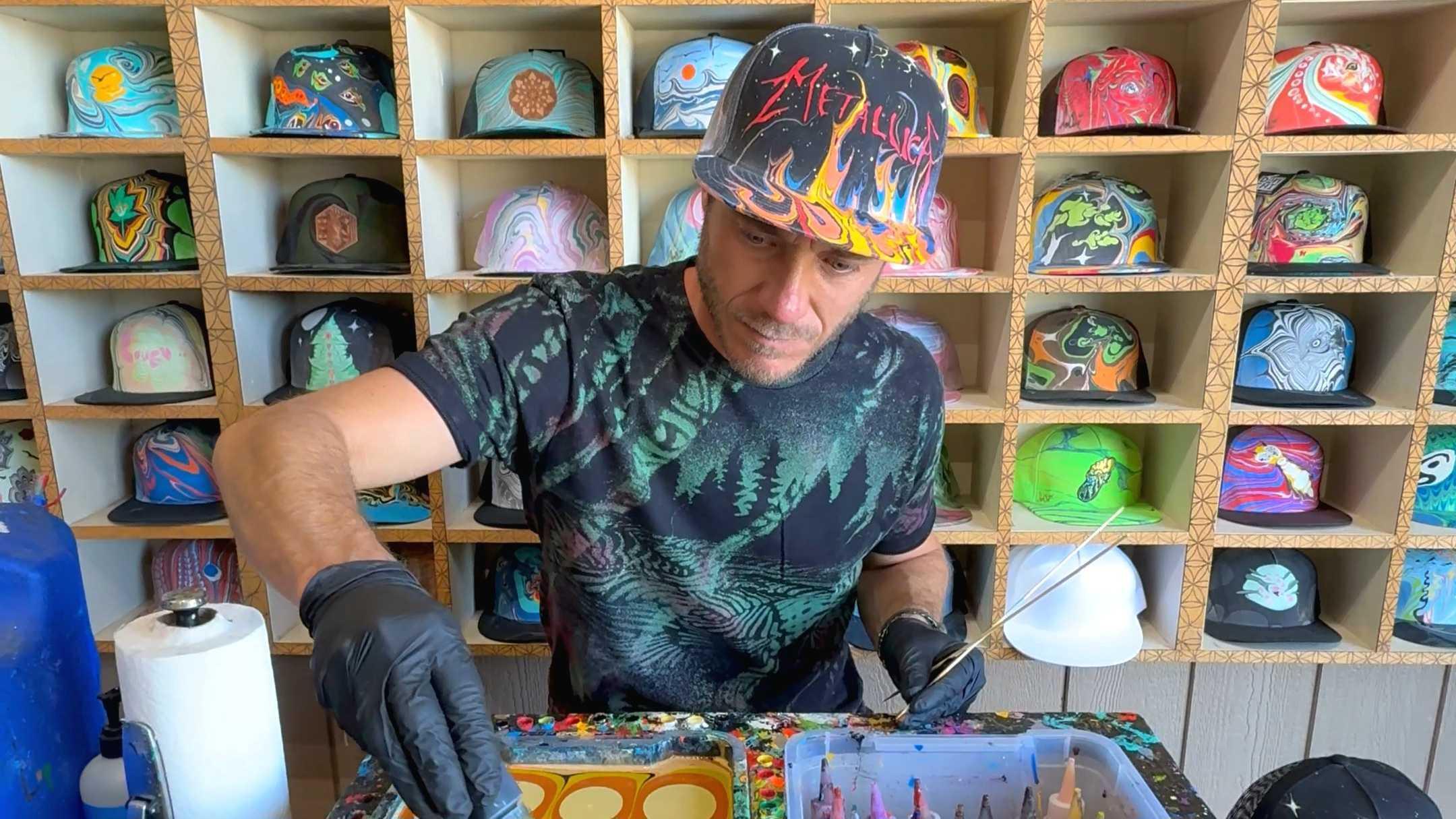
Looking Back on 2025
Some words and photos to look back on the year that was from So What! Editor Steffan Chirazi.
Nov 19, 2021
The artist behind the imagery on Metallica’s super-exclusive and rather spectacularly cool, special-edition Clue game, Maxx242, has grit, soul, and quality. Here, the LA-based artist takes some time to answer Steffan Chirazi on key thoughts and moments in his (quite literally) illustrious career as a multidisciplinary creative force.
1. So, from NJ to Cali with a pretty eventful childhood, it appears… I saw somewhere that you spoke of street art you saw in Korea Town as being what you thought was “the norm.” Were there pieces in particular that engaged you, and did it get you looking at other scenes in, say, Miami and NY?
I was really young. I really don’t remember many of the writers or crews I saw at the time. Cab and Sleeze always stood out to me, though. As I dove further into Graffiti at the time, there were only a few movies and books out on graffiti art, Subway Art and Street Art being the main books I found. Seen (a graffiti artist) was probably my favorite from NY.2. I have to ask… you’ve seen the film Bombin’, right?
Yeah, man, it’s been a while. I think that came out in the late ’80s. Damn, I’m old!3. What were the first lines, shapes, and colors you drew regularly, and on what/where? What was the first piece of graffiti art you did?
I always want to say that I am a mark maker first. I used to just draw swirly circles and random lines that really didn’t form anything. At times just hatching marks and cross-hatching. I always did those lines that went from point to point, at a 90-degree angle, forming a round transitional shape. I always thought that it was interesting how straight lines could form such a perfect-looking circle shape. My first piece was under a bridge in Riverside, CA. My friend Jeff showed me the spot; we painted there a few more times. It was very discrete. I painted my old graffiti name at the time.
4. You love baseball yet crave the power of isolation in creation. Explain that dichotomy?
Even though baseball is a team sport, I feel that like skateboarding and art, it begins with self-competition. When you’re up to bat, you don’t rely on someone else passing you a ball or if someone else will complete a play to help your team to victory. It’s really just you and your own abilities. It’s the same with making the play on the field or pitching. Skateboarding was my first love; it’s where I found my ability and understanding of self-growth and pushing through challenges that may seem impossible at times. Pushing through frustration and failure. Even though drawing and painting are not performance art or sport, there is so much work inside. The frustration and failures are there just the same. I feel that baseball is the same way. When you strike out and the game is on the line, that frustration and loneliness are just the same.5. You speak of being downtrodden. Explain how and explain the role graffiti had in your flipping those tables?
I didn’t have the most supportive environment as a kid. Not the ideal family life. I was always a little jealous of my friends when they got to go home and have dinner with their mom and dad. I never had that. Things got dark at times. I had no sense of self-worth or value. My mother was an amazing woman; I don’t know how she did everything she did. Even at that, I was alone a lot. Skateboarding and graffiti art really allowed me to find my voice. Especially graffiti art, I felt like I was screaming, and you couldn’t escape it because it was right there in front of you. It was an amazing rush. As I grew and got better at it, other kids began to recognize me. Well, not really me, but my name. It was all a big secret back then due to the illegal nature of graffiti art. I also found a group of misfits that shared similar stories. They became the family I always craved. We got into so much mischief… it was fun! I found my self-worth.6. Dayna Mason. Let’s give her some props here for the role she appears to have played in taking your raw, untrained skill and helping hone it into a superlative craft.
Dayna Mason was one of our teachers at Riverside Community College. When I got to her class, I thought, “Oh yeah, I got this, gonna ace this.” I thought I knew it all, along with a few other artists. Dayna was like a drill sergeant. Oh man, she broke us down! I think I actually tried to quit her class, but she wouldn’t let me. I don’t know why, but Dayna just believed in us even when we didn’t believe in ourselves. I remember at one point, she was going through a technique… that was the moment I realized, “Wow! I really don’t know much.” I realized just how amazing she really was. From that day forward, I really began to listen and just learn from her. It was as if I had taken the blue pill, like I took off the blindfold and was really able to see. Dayna is an amazing artist and a phenomenal teacher.
7. When doing pieces today, how much of the graffiti street dimensions/scope/breadth/frame do you bring? Has it been hard over the years to scale down? To that end, what scale do you enjoy working with more: large expanses or smaller, tighter pieces?
The scale of a wall and painting graffiti art always felt very natural. Drawing and painting as far as my arm can go. Your shoulder functions as a center point, and your legs allow you to go lower or higher. Maybe because I was skateboarding for so many years, understanding and utilizing my whole body to create felt normal. Scaling art down wasn’t much different. Instead of utilizing my shoulder, I use my wrist or elbow as the center point, depending on the size of the canvas. I love working large. There is just so much you can create. I have yet to explore the full potential of working larger due to time, but it’s something I want to do sooner than later. I think the biggest difference for me on the scale of a canvas becomes time. A smaller-scale piece you can usually come back to and spend days and weeks on. Even if it’s a few hours a day just chipping away at it. For me, regardless of size, it’s all in the details.8. Women feature heavily in your work; I was interested to know the reasons. Who is Catrina based upon?
Growing up in a Hispanic household, I saw how incredibly strong women are. My mother, my aunts, and grandmother were so resilient. No matter how challenging things got, how many times they fell down, they always got back up and kept going. Simply amazing. The Catrina piece is based off of an illustration by José Posada. He was a Mexican-born lithographer from the late 1800s. It was the inspiration for many pieces today that focus on the Mexican Day of the Dead holiday. As most artists do, I took the idea and created my own image from the Catrina story. There are definite references to women that have come across my path in life as well.9. While dark, your work does not have any demonic elements per se. You avoid the devil/satanic areas to my eye. Skulls/reapers can often lead there. How come not in your case?
I have definitely danced on that line and crossed it at times, but I think there hasn’t been anything that has really stuck and that I’ve completed. In general, I’m not a religious person, but I respect that some symbols and images resonate strongly in many people’s beliefs. For me to create an image using symbols with great meaning, dark or light, it really has to mean something to me. I don’t set out to offend; I do understand that art will have that effect on people whether I am aiming to or not. I believe I haven’t had a strong enough reason to utilize these symbols and create these images.10. Did you ever play Clue? What instructions were you given when crafting the images for the Metallica game?
Yes, my kid and I love playing that game. We were mostly given the specs for the production of the game, as well as the storyline. Which is very similar to the classic game. Oh, I did receive images of their headquarters! That was awesome to see. Hope to one day get the opportunity to grace their walls there with some aerosol art! Even with such an elaborate project, the Metallica team always allows us artists to add to their story and just create and be artists. It was an amazing experience to help create this game with them.

Some words and photos to look back on the year that was from So What! Editor Steffan Chirazi.

Dominic Padua (aka Dom Chi) does many things very well, including the art of marbling. Steffan Chirazi visits his Sebastopol, CA, studio to learn more.

What you are diving into here is my personal journal with regards to the Back to the Beginning extravaganza. Much of it was written off-the-cuff, and the sheer magnitude of the event means that even now there are still pieces of “thought” swirling in the ether and making brain fall by the hour. These recollections, emotions, and observations are shared reflectively over three separate entries after the event and are split between an initial “post-event download” and then a more chronological reflection on our time in Birmingham…